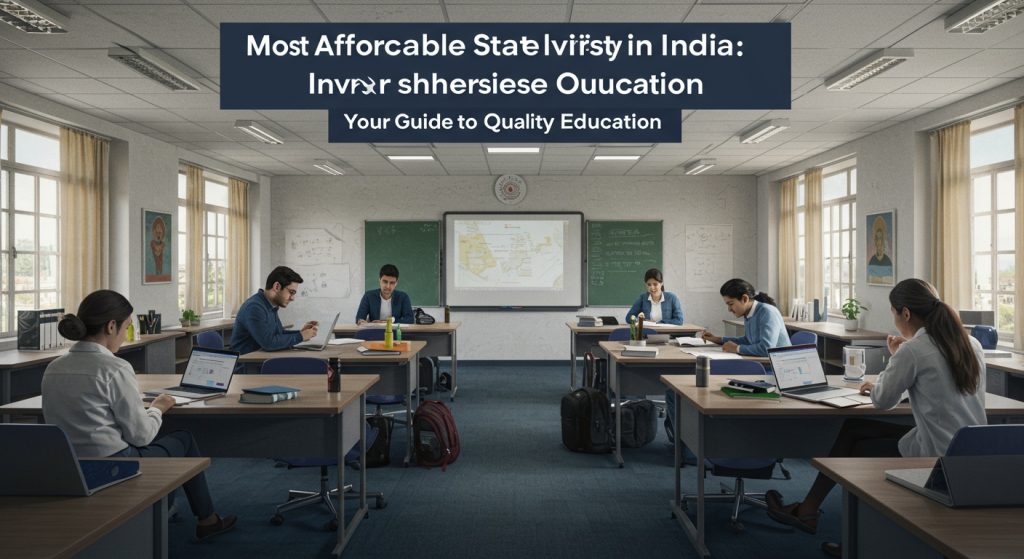India’s research landscape is rapidly evolving, fueled by increased government investment and a push for innovation across sectors. As we approach 2025, understanding the institutions leading this charge is crucial. The Indian Institutes of Technology (IITs), for instance, are expanding their research focus beyond traditional engineering, with significant funding directed towards AI and sustainable technologies. Simultaneously, universities like the Indian Institute of Science (IISc) continue to excel in fundamental research, attracting substantial grants for cutting-edge projects in areas like quantum computing and advanced materials. This exploration unveils the top government-funded research universities, providing insights into their specializations, funding allocations. Emerging areas of focus that are shaping India’s future.

Understanding Government-Funded Research Universities in India
Government-funded research universities in India play a pivotal role in driving innovation, fostering academic excellence. Contributing to the nation’s socio-economic development. These institutions receive substantial financial support from the central and state governments, enabling them to invest in cutting-edge infrastructure, attract top-tier faculty. Offer a wide range of academic programs.
A research university, in the Indian context, is typically defined by its commitment to:
- Conducting high-impact research across various disciplines.
- Offering postgraduate and doctoral programs.
- Collaborating with industry and other research organizations.
- Contributing to policy-making through evidence-based research.
Government funding for these universities is channeled through various agencies, including the University Grants Commission (UGC), the Department of Science and Technology (DST). The Ministry of Education. The funding is often allocated based on factors such as research output, faculty qualifications, infrastructure. The university’s contribution to national priorities.
Key Criteria for Evaluating Research Universities
Several key criteria are used to evaluate the performance and standing of research universities. These metrics help prospective students, researchers. Policymakers assess the quality and impact of these institutions. Some of the most crucial criteria include:
- Research Output: This encompasses the number of research publications, citations, patents. Other forms of intellectual property generated by the university’s faculty and students.
- Faculty Expertise: The qualifications, experience. Research contributions of the faculty members are critical indicators of a university’s research capabilities.
- Infrastructure: State-of-the-art laboratories, libraries, computing facilities. Other infrastructure are essential for conducting high-quality research.
- Funding and Resources: The availability of funding from government and private sources enables universities to support research projects, attract talent. Upgrade infrastructure.
- Collaborations and Partnerships: Collaborations with industry, government agencies. Other research institutions enhance the relevance and impact of research.
- Rankings and Accreditation: National and international rankings, such as the National Institutional Ranking Framework (NIRF). Accreditation from bodies like the National Assessment and Accreditation Council (NAAC), provide an external validation of a university’s quality.
- Student Outcomes: The success of graduates in terms of employment, further studies. Entrepreneurial ventures is an vital measure of a university’s overall effectiveness.
Spotlight on Top Performers: A Glimpse into 2025
While rankings and performance can fluctuate, some government-funded research universities in India consistently demonstrate excellence across various disciplines. These institutions are often at the forefront of research and innovation.
Here are a few examples, keeping in mind that this is a snapshot based on current trends and anticipated developments by 2025:
- Indian Institute of Science (IISc), Bangalore: IISc is renowned for its cutting-edge research in science and engineering. It consistently ranks among the top research institutions in India and globally. IISc’s strengths lie in areas such as materials science, artificial intelligence. Aerospace engineering. The institute is actively involved in collaborative research projects with industry and government agencies.
- Indian Institutes of Technology (IITs): The IITs, particularly IIT Bombay, IIT Delhi, IIT Madras, IIT Kanpur and IIT Kharagpur, are premier engineering and technology institutions with a strong focus on research. They offer a wide range of programs in engineering, science. Technology. Their faculty members are actively involved in research across various domains. The IITs have been instrumental in driving technological innovation in India.
- Jawaharlal Nehru University (JNU), Delhi: JNU is a leading research university in the humanities and social sciences. It is known for its interdisciplinary approach to research and its focus on social justice and development. JNU’s faculty members are actively involved in research on a wide range of issues, including economics, political science, sociology. International relations.
- Banaras Hindu University (BHU), Varanasi: BHU is a comprehensive university with a strong focus on research in science, engineering. The humanities. It is known for its contributions to areas such as agriculture, medicine. Sanskrit studies. BHU has a large and diverse student body and a strong alumni network.
- University of Delhi (DU), Delhi: DU is a leading research university with a strong focus on science, humanities. Social sciences. It is known for its contributions to areas such as physics, chemistry, economics. History. DU has a large and diverse student body and a strong alumni network. Many of its constituent colleges also excel in specific research areas.
Case Studies: Research Impact in Action
To illustrate the impact of research conducted at these universities, let’s consider a few case studies:
- IIT Madras’s Affordable Housing Technology: Researchers at IIT Madras have developed innovative and cost-effective housing technologies that are helping to address the housing shortage in India. These technologies utilize locally available materials and construction techniques to build durable and affordable homes. This research has had a significant impact on the lives of low-income families.
- IISc Bangalore’s AI-Powered Healthcare Solutions: IISc Bangalore is at the forefront of developing AI-powered healthcare solutions that can improve the accuracy and efficiency of diagnosis and treatment. Researchers at IISc have developed AI algorithms that can detect diseases such as cancer and tuberculosis at an early stage. These technologies have the potential to transform healthcare in India.
- JNU’s Research on Climate Change and Sustainable Development: JNU’s faculty members are actively involved in research on climate change and sustainable development. Their research is helping to inform policy decisions and promote sustainable practices. JNU’s research has contributed to a better understanding of the challenges posed by climate change and the opportunities for sustainable development.
The Role of Government Policies and Funding
Government policies and funding play a crucial role in shaping the research landscape in India. The government has launched several initiatives to promote research and innovation, including the:
- National Education Policy (NEP) 2020: The NEP 2020 emphasizes the importance of research and innovation in higher education. It aims to create a more conducive environment for research by promoting interdisciplinary studies, providing funding for research projects. Encouraging collaborations between universities and industry.
- Higher Education Funding Agency (HEFA): HEFA provides financial assistance to higher education institutions for infrastructure development and research projects. HEFA has played a key role in upgrading the infrastructure of many government-funded research universities.
- Prime Minister’s Research Fellowship (PMRF): The PMRF provides fellowships to outstanding students to pursue doctoral studies at IITs, IISc. Other top research institutions. The PMRF aims to attract and retain talent in the field of research.
These policies and funding initiatives are helping to create a more vibrant and dynamic research ecosystem in India. But, there are still challenges to be addressed, such as the need for increased funding for research, the need to improve the quality of research. The need to promote greater collaboration between universities and industry.
Future Trends and Challenges
Looking ahead to 2025 and beyond, several trends and challenges are likely to shape the landscape of government-funded research universities in India:
- Increased Focus on Interdisciplinary Research: There will be a growing emphasis on interdisciplinary research that addresses complex societal challenges. This will require universities to foster collaborations between different departments and disciplines.
- Integration of Technology in Research: Technology will play an increasingly essential role in research. Universities will need to invest in advanced computing facilities, data analytics tools. Other technologies to support research activities.
- Emphasis on Innovation and Entrepreneurship: Universities will be expected to play a greater role in promoting innovation and entrepreneurship. This will require universities to provide support for start-ups, incubators. Other entrepreneurial ventures.
- Globalization of Research: Research will become increasingly globalized. Universities will need to forge partnerships with institutions around the world to collaborate on research projects and share knowledge.
- Addressing Funding Gaps: Securing sufficient and sustained funding will remain a key challenge. Universities will need to explore diverse funding sources, including government grants, industry partnerships. Philanthropic donations.
- Attracting and Retaining Talent: Competition for top-tier faculty and researchers will intensify. Universities will need to offer competitive salaries, research support. Career development opportunities to attract and retain talent.
Making Informed Choices: A Guide for Students and Researchers
Choosing the right research university is a crucial decision for students and researchers. Here are some factors to consider:
- Research Interests: Identify universities that have strong research programs in your area of interest.
- Faculty Expertise: Research the faculty members in your field of study and their research contributions.
- Infrastructure and Resources: Assess the availability of state-of-the-art laboratories, libraries. Other infrastructure.
- Funding Opportunities: Explore the funding opportunities available at the university, such as scholarships, fellowships. Research grants.
- Location and Environment: Consider the location of the university and the overall learning environment.
- Rankings and Accreditation: While not the sole determinant, rankings and accreditation can provide a useful indication of a university’s quality.
- Career Prospects: Research the career prospects for graduates from the university in your field of study.
By carefully considering these factors, students and researchers can make informed choices and select a research university that aligns with their academic and career goals. For students aiming to study at one of the top State Universities in India, researching these aspects beforehand can be immensely helpful.
Conclusion
Navigating the landscape of India’s top government-funded research universities in 2025 requires more than just glancing at rankings. It demands a strategic approach, focusing on aligning your academic aspirations with each institution’s research strengths and evolving specializations. Remember, recent developments in fields like AI and sustainable energy are reshaping research priorities, so look for universities actively investing in these areas. For instance, IIT Madras’s strides in AI and robotics showcase this trend. My personal tip? Don’t underestimate the power of networking. Reach out to current students or faculty in your field of interest. Their insights can provide invaluable perspectives beyond brochures and websites. Ultimately, choosing the right university is an investment in your future. Embrace the challenge, explore the options. Remember that your passion and dedication are just as crucial as the institution’s reputation. Now, go forth and make your mark!
More Articles
Top Central Universities in India: Latest Rankings & What Makes Them Stand Out
Most In-Demand Courses: Central Universities to Watch Out for in 2025
NIRF 2024 Ranking: Which Central University Tops Engineering This Year?
AI in the Classroom: How AI Will Change University Education
Unlock Your Potential: Research Opportunities for Undergraduates
FAQs
Okay, so what exactly makes a research university ‘government-funded’ in India? What are we talking about here?
Good question! , it means the university gets a significant chunk of its operating budget and research grants from the Indian government, either directly from central ministries or through state governments. This funding lets them invest heavily in research infrastructure, hire top-notch faculty. Offer scholarships. Think of it as the government putting its money where its mouth is when it comes to advancing knowledge!
How is this ‘2025 guide’ different from, say, a list from last year? What’s changed?
Well, things are always evolving! University rankings fluctuate, new programs emerge. Research priorities shift. This guide aims to reflect the current landscape, taking into account recent funding trends, research output, faculty quality. Any major developments happening at these institutions as of 2024 and projecting into 2025. It’s about staying up-to-date!
Is it just about the IITs? Or are there other types of universities on this list?
While the IITs (Indian Institutes of Technology) are certainly prominent players and often top the charts, the guide includes a diverse range of institutions. You’ll find central universities like Jawaharlal Nehru University (JNU), Banaras Hindu University (BHU). Specialized research institutes like the Indian Institute of Science (IISc) Bangalore, among others. It’s not just about engineering!
So, if I’m looking at this guide to pick a university for my Master’s, what should I actually look for?
That depends on your priorities! First, identify the field you’re interested in and see which universities are strong in that area. Then, check out the faculty profiles – are there professors whose research aligns with your interests? Look at the research facilities available – do they have the equipment you’ll need? Finally, consider location, student life. Career opportunities post-graduation. It’s a holistic decision.
Does ‘government-funded’ mean the education is free? Fingers crossed!
Ah, if only! While government funding helps keep tuition fees lower than private institutions, it doesn’t usually mean completely free education. You’ll still likely need to pay tuition and other fees, though scholarships and financial aid are often available, especially for meritorious students or those from disadvantaged backgrounds. It’s worth exploring those options!
What are the ‘top’ universities being judged on, exactly? Is it just research papers published?
It’s more than just publications, though research output is a significant factor. The ‘top’ universities are usually assessed based on a combination of things: research publications and citations, faculty qualifications and experience, student-faculty ratio, infrastructure, funding received, international collaborations. Even things like the number of patents filed. It’s a multi-faceted evaluation.
If a university isn’t on this ‘top’ list, does that mean it’s not worth considering for research?
Not at all! This guide focuses on the top government-funded research universities. There are plenty of other excellent institutions in India doing valuable research. A university not being on this particular list doesn’t automatically disqualify it. It might be strong in a specific niche area, or perhaps it’s a rising star that’s not yet reached the top tier. Do your own research beyond this guide!



